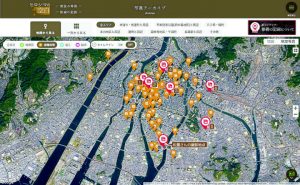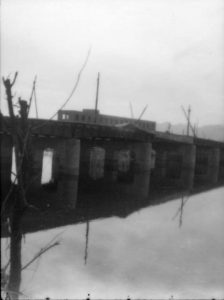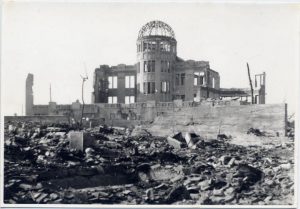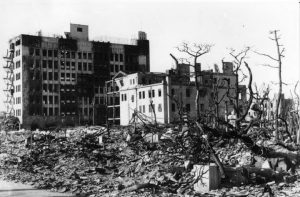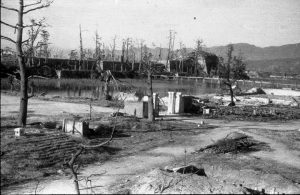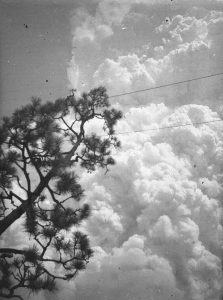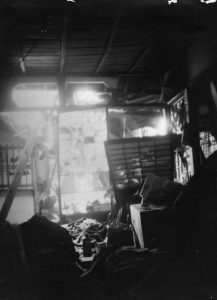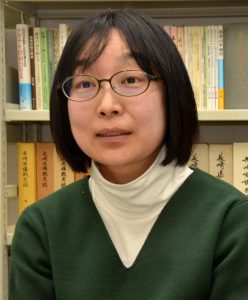Striving to fill voids in Hiroshima, evidence of victims remains in records of A-bombing disaster—Photos describe completely transformed lives, record photographers’ recollections
Jan. 3, 2022
View of city before and after destruction
Photos not carried in paper also included
by Junji Akechi and Kyosuke Mizukawa, Staff Writers
On January 3, the Chugoku Shimbun updated its website “Striving to fill voids in Hiroshima—Recreating cityscapes.” Newly released content has been posted under the title “Records of A-bombing disaster,” including more than 100 photographs that record the destruction caused by the U.S. atomic bombing of the city on August 6, 1945. The photos reveal horrific scenes of wounded people and destroyed structures. The website will be used to continue communicating to future generations the inhumane nature of nuclear weapons, which must never be used again.
The A-bomb’s mushroom cloud witnessed from beneath, a smoldering cityscape, and people with burns over their entire body. The new photographic record introduced in “Records of A-bombing disaster” conveys the reality of the damage caused by the atomic bombing. Many of the photographs represent records left behind by members of the Hiroshima public who themselves were wounded in the atomic bombing.
On the website, just as in the past, users can click on a pinned area of the map to bring up a series of photos taken at that particular spot. New to the website page, however, are large pink pin icons. Clicking the pink pins will reveal not only photos but also related articles published by the Chugoku Shimbun that provide the backstory as to why the person took the photographs as well as their thoughts and feelings at that moment. Photographs that were not carried in the print version of the newspaper because of space limitations are also included.
One of the photographers is Yoshito Matsushige, a photojournalist for the Chugoku Shimbun who died in 2005 at the age of 92. He took a historic photograph at the west end of the Miyuki Bridge (now part of Hiroshima’s Naka Ward) that captured the appearance of survivors in the aftermath of the atomic bombing. Although he had hesitated to take the photo because of the horrifying conditions, he ultimately made the decision to snap the shutter with tears streaming down his face.
Another photographer, Mitsugi Kishida, who died in 1987 at the age of 71, took photos of the completely destroyed Hondori shopping street on August 7, the day after the atomic bombing. He had entered the shopping street area on August 6, the day of the atomic bombing, but was unable to take photos of people who were suffering and in such agony. Isao Noda, the only one of six family members that survived the atomic bombing and who died in 2017 at the age of 92, took photos of the destroyed Hiroshima Prefectural Industrial Promotion Hall (now the A-bomb Dome) in the autumn of 1945.
Our site has thus far posted about 1,200 photographs depicting the daily lives of Hiroshima’s people before the atomic bombing. When compared with those uploaded in the newly created “Records of A-bombing disaster,” a vivid image of Hiroshima’s cityscape before and after the bombing emerges. The website will continue to introduce a wide selection of new photos of record confirmed in recent years.
New content on website
Includes more than 100 additional photos taken after the atomic bombing
1. Aioi Bridge: Isao Kita
This photograph of Aioi Bridge was taken in late September 1945, near the present-day Hiroshima Chamber of Commerce, by the late Isao Kita, who worked for the Hiroshima District Meteorological Observatory (now the Hiroshima Local Meteorological Observatory). Part of the sidewalk had buckled from the force of the A-bomb blast. The Honkawa National School (now the Honkawa Elementary School) can be seen at rear. Mr. Kita walked around the city center as well as in surrounding cities and towns during surveys conducted by the Special Committee for the Investigation of A-bomb Damage, established by a research council at Japan’s former Ministry of Education.
2. Hiroshima Prefectural Industrial Promotion Hall: Isao Noda
This photograph of the Hiroshima Prefectural Industrial Promotion Hall (now the A-bomb Dome) was taken in the autumn of 1945 by the late Isao Noda, who worked for the former Army Clothing Depot (now part of the city’s Minami Ward). Mr. Noda lost his parents and four siblings in the atomic bombing. On the morning of August 6, after breakfast with his family, he was passing by the Industrial Promotion Hall en route to work at the Clothing Depot. (Photo provided by Isao Noda and archived at the Hiroshima Peace Memorial Museum)
3. Fukuya Department Store’s old and new buildings: Kazuma Hayashi
This photograph of the new (left rear, now the Fukuya Hatchobori Main Store) and old (in foreground) buildings of the Fukuya Department Store was taken in the autumn of 1945 by the late Kazuma Hayashi, who worked at the department store. The buildings were located approximately 700 meters from the hypocenter, resulting in their interior being gutted and charred. The new building is currently registered as an “A-bombed building” by the Hiroshima City government, while the old building was demolished after the war.
4. Hiroshima Army Cadet School: Yoshio Tanihara
This photograph, taken by the late Yoshio Tanihara, who operated a photo studio in Kitakyushu City, shows the remains of the front gate of the Hiroshima Army Cadet School (center) and the collapsed tower of Hiroshima Castle (right rear). His parent’s home was near the castle, and his father died in the atomic bombing. The school was destroyed in the bombing, except for some of its buildings. The photograph was taken some time between late August 1945 and the end of the same year. (Photo donated by Yoshio Tanihara and archived at the Hiroshima Peace Memorial Museum)
5. Mushroom cloud: Toshio Fukada
This photograph of the mushroom cloud was taken by the late Toshio Fukada from his location at the Hiroshima Army Ordnance Supply Depot (now the Hiroshima University Kasumi Campus), where he had been mobilized. This is one of four photos in existence thought to have been taken five to 10 minutes after the bomb detonated. Mr. Fukada was a camera hobbyist and was carrying one in his pocket at the time of the atomic bombing. From the window on the second floor of the weapons arsenal, he instantly aimed his camera at the billowing smoke, the likes of which he had never before witnessed. (Photo provided by the Hiroshima Peace Memorial Museum)
6. Interior of house: Fukushi Neishi
This photograph shows the interior of a house in the area of Atago-cho (now part of Hiroshima’s Higashi Ward) that belonged to Fukushi Neishi, who took the photo. Located approximately 2.3 kilometers from the hypocenter, the house’s sliding doors were blown apart by the blast. Mr. Neishi, who experienced the atomic bombing at his home, told his family he took the photograph immediately after the bombing. Staff at the Hiroshima Peace Memorial Museum believe the photograph was taken on that day or within a few days of the atomic bombing. (Donated by Yayoi Neishi and archived at the Peace Memorial Museum)
Preservation of materials through public/private partnership
Chie Shijo, associate professor at Hiroshima City University
Chie Shijo, former curator at the Hiroshima Peace Memorial Museum, located in the city’s Naka Ward, and now an associate professor at Hiroshima City University’s Hiroshima Peace Institute, is known for her detailed knowledge of the preservation of materials related to the atomic bombing. She was interviewed by the Chugoku Shimbun about the significance of, and problems associated with, the preservation and use of photographic records depicting the damage and destruction caused by the atomic bombing. Below is the interview with Ms. Shijo.
-- What do you think about the significance of such a photographic record?
Such photographs have incredible power to evoke images of the realities of those days and can even convey concepts and emotions that exceed our own imagination. Regarding this point, the photos are an important record. On the other hand, as they also are appealing, they tend to cause people to be aware only of what appears in each particular photographic frame. The photos taken immediately after the atomic bombing are limited in number. We should not forget that there was much more than what remained in the photographs.
-- What do you think about posting such information on the internet?
The website “Striving to fill voids in Hiroshima” provides less information on the Funairi district in Hiroshima, for example, than that related to the city center, even though all of the buildings in the district were incinerated in the same way as were the structures in the city’s central area. If it is able to fill such voids, the website will become ever more meaningful. For photos, the preservation of not only digital data but also such originals as rolls of film (to prevent alterations) is an important issue. Long-term preservation is a role that public institutions need to fulfill, but such work requires financial resources. As the volume of materials continues to increase, caring for the materials using only facilities independent of each other such as museums is becoming more difficult. Therefore, a network that transcends the public and private sectors needs to be created for the preservation of materials related to the atomic bombing, including photographs and printed documents.
-- What do you think is the role of the news media?
The role of the media is to uncover and communicate events or materials from a new perspective. It is also important for the media to link newly discovered materials with the act of public preservation. I hope the website will help to strengthen those specific functions.
(Originally published on January 3, 2022)

